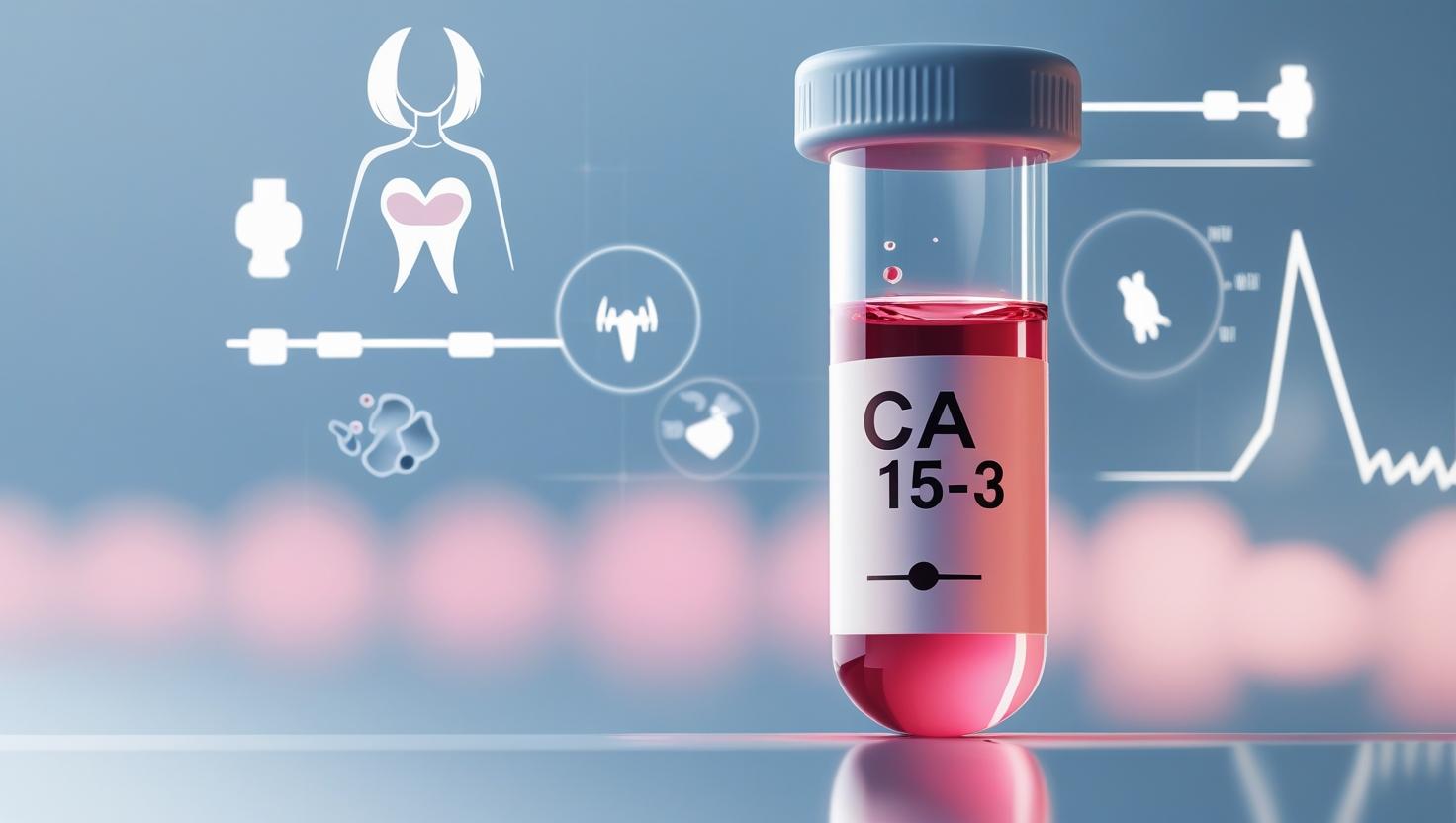Cancer markers can be confusing for many people, especially when it comes to understanding what the numbers mean and how they affect your health. One of the most commonly discussed markers in breast cancer management is CA 15-3. In this blog, we will break down everything about CA 15-3 in simple language, including what it is, why it is important, how it is measured, and how it is interpreted.

What is CA 15-3?
CA 15-3, short for Cancer Antigen 15-3, is a protein that is found on the surface of certain cells, primarily in breast tissue. It is part of a larger group of proteins called mucins, which play a role in cell signaling and protection.
In a healthy body, CA 15-3 levels are usually low in the blood. However, in some conditions—particularly breast cancer—the levels may increase. This makes CA 15-3 a tumor marker, which is a substance that can help doctors monitor cancer progression or response to treatment.
It is important to note: CA 15-3 is not a definitive test for cancer diagnosis. Its main role is in monitoring known breast cancer cases rather than screening healthy individuals.
How is the CA 15-3 Test Done?
The CA 15-3 test is a simple blood test. Here’s what typically happens:
- A healthcare professional draws a small amount of blood from a vein, usually in your arm.
- The blood is sent to a laboratory for analysis.
- The lab measures the amount of CA 15-3 in the serum (the liquid part of the blood).
- Results are usually available within a few days.
The procedure is quick and generally painless, similar to any routine blood test.
Normal CA 15-3 Levels
CA 15-3 levels are measured in units per milliliter (U/mL).
- Normal range: Usually 0–30 U/mL, although this may vary slightly depending on the lab and the method used.
- Slightly elevated: 31–50 U/mL (may be caused by benign conditions)
- High: Above 50 U/mL (often seen in breast cancer or metastasis)
It’s important to understand that a slightly high CA 15-3 does not automatically mean cancer. Other conditions such as liver disease, benign breast conditions, ovarian cysts, or even normal fluctuations can sometimes raise the levels.
Why is CA 15-3 Important?
CA 15-3 is most useful in monitoring breast cancer patients, especially after diagnosis or treatment. Here’s why:
- Tracking Treatment Response: If a patient is undergoing chemotherapy, hormonal therapy, or targeted therapy, CA 15-3 levels can indicate how well the treatment is working. A decline in CA 15-3 usually suggests that the cancer is responding.
- Detecting Recurrence: After successful treatment, rising CA 15-3 levels may be an early sign of cancer recurrence, even before symptoms appear.
- Monitoring Advanced Cancer: In metastatic breast cancer (cancer that has spread), CA 15-3 can help track disease progression and guide treatment adjustments.
Conditions That Can Affect CA 15-3 Levels
While CA 15-3 is primarily associated with breast cancer, its levels can also be influenced by other conditions:
- Other cancers: Ovarian, lung, liver, or pancreatic cancer
- Benign breast conditions: Fibroadenoma or cysts
- Liver disease: Hepatitis or cirrhosis
- Other medical conditions: Rheumatoid arthritis, pregnancy, or infections
Because of this, CA 15-3 cannot be used alone for diagnosis. Doctors often combine it with imaging tests, physical exams, and other markers for a complete picture.
How CA 15-3 is Used in Clinical Practice
1. During Breast Cancer Diagnosis
Although CA 15-3 is not a screening test, doctors may sometimes measure it at diagnosis to get a baseline. This helps in monitoring treatment effectiveness later.
2. Monitoring Treatment
- Chemotherapy: A falling CA 15-3 level usually means the therapy is effective.
- Hormonal therapy: Similar trends can be observed with drugs like tamoxifen or aromatase inhibitors.
- Targeted therapy: Medications such as trastuzumab (Herceptin) may also be monitored using CA 15-3 levels.
3. Detecting Recurrence
Regular CA 15-3 tests after treatment can detect recurrence early. For example:
- If levels were 25 U/mL post-treatment but later rise to 60 U/mL, the doctor may order imaging studies to check for recurrence.
4. Prognosis in Advanced Cancer
Higher CA 15-3 levels often correlate with tumor burden in metastatic breast cancer. While it cannot predict exact outcomes, trends in CA 15-3 can help guide treatment intensity.
Interpreting CA 15-3 Results
Interpreting CA 15-3 requires understanding both absolute values and trends over time:
- Stable normal levels: Usually indicate no active disease.
- Rising levels: May suggest cancer progression or recurrence.
- Falling levels: Suggest treatment is effective.
Doctors look at percentage changes over time rather than a single reading. For example:
- A 20–30% increase over 2–3 consecutive tests may be more meaningful than a one-time high reading.
- Sudden spikes may require confirmation and correlation with imaging or other tests.
Limitations of the CA 15-3 Test
It is important to remember the limitations of CA 15-3:
- Not for Screening: CA 15-3 cannot replace mammograms or breast exams for detecting cancer.
- False Positives: Benign conditions may elevate CA 15-3 levels.
- Not 100% Sensitive: Some breast cancers, especially early-stage or certain types, may not elevate CA 15-3 at all.
- Best as Part of a Panel: Doctors often use other markers like CEA (Carcinoembryonic antigen) alongside CA 15-3 for more accurate monitoring.
Preparing for the CA 15-3 Test
No special preparation is usually required. Some tips:
- Follow your doctor’s instructions about fasting, if any.
- Inform your doctor about any medications or supplements you are taking.
- Try to get tested at the same lab every time for consistent results.
CA 15-3 and Lifestyle Factors
While lifestyle changes cannot directly reduce CA 15-3 levels, maintaining overall health can improve cancer outcomes:
- Healthy diet: Fruits, vegetables, whole grains, and lean proteins
- Regular exercise: Helps boost immunity and overall well-being
- Avoid alcohol and smoking: Reduces cancer risk and improves treatment outcomes
- Routine follow-ups: Essential for timely monitoring and management
Frequently Asked Questions (FAQs)
Q1: Can a healthy person have high CA 15-3?
Yes. Sometimes benign conditions, liver diseases, or even normal variation can cause mildly elevated levels.
Q2: How often should CA 15-3 be checked?
For patients undergoing treatment or follow-up, doctors may check every 3–6 months or as clinically indicated.
Q3: Can CA 15-3 predict survival?
It is not a definitive predictor, but rising trends in advanced cancer may indicate disease progression.
Q4: Can pregnancy affect CA 15-3?
Yes. CA 15-3 levels can slightly rise during pregnancy, but usually not to a concerning extent.
Q5: Is CA 15-3 the only marker for breast cancer?
No. Other markers like CEA and imaging studies (mammogram, MRI, PET-CT) are also important for monitoring and diagnosis.
Key Takeaways
- CA 15-3 is a tumor marker primarily used to monitor breast cancer.
- It is not a diagnostic tool and should not replace screening methods.
- Interpretation depends on trends over time rather than a single value.
- Levels can be influenced by benign conditions, other cancers, and lifestyle factors.
- Regular monitoring helps in tracking treatment response and detecting recurrence early.
Conclusion
Understanding CA 15-3 can be overwhelming, but breaking it down into simple concepts makes it easier. Remember that CA 15-3 is just one piece of the puzzle in managing breast cancer. It helps your doctor monitor treatment effectiveness and detect potential recurrence, but it should always be interpreted alongside imaging, clinical evaluation, and other laboratory tests.
If you or a loved one has breast cancer, regular follow-ups and discussions with your oncologist about CA 15-3 trends can be a vital part of personalized care. Knowledge about this marker empowers patients to participate actively in their treatment journey and make informed decisions.
